For those of you who remember Special Forces in the early 90's...this is for you.
For those that werent around, this publication was one of the things that made us different....we were more defiant. Even now, after achieving success and having risen through the ranks...this publication makes sense...its about issues that confronted us then and still do now. It about telling some bitch that toilet paper is NOT a luxery...standing up to fight for the outstanding NCOs we have in Group. Read at your own risk!
THE RESISTER
The Official Publication of the Special Forces Underground.
Volume I, Number 1. Summer 1994.
Boxholder, P.O. Box 1403, Addison, Texas, 75001
(Price) GRATIS
EDITORIAL POLICY
Welcome to this, our first issue of The RESISTER. Over the years, we have seen so many attempts to produce so-called underground newspapers treating the issues that concern the various special forces groups in general, and the special operations community in particular. Our only response to such efforts is disgust.
For an organization that is touted as the elite of our armed forces, past attempts to expose the ineptitude of our command, the incompetents in our officer and non-commissioned officer corps, and the inequities and injustices of whimsical policies have been embarrassingly amateurish. Casual reading of the myriad publications masquerading as underground newspapers reveals them as unconscionable drivel; snivel sheets hacked out by a couple of disgruntled want-to-be's venting their collective spleen about issues they do not understand while sitting around a lap-top computer in their team room drinking beer. If found out, these incompetents deserve expulsion from Special Forces for bringing dishonor on the traditions of Ethan Allen, T.E. Lawrence, Orde Wingate, Roger Trinquier, Frank Kitson, Vo Nguyen Giap, Collin Gubbins, and Denis Sefton Delmer.
The editorial policy of The RESISTER is simple.
First we publish only the pertinent. We will not publish whining, invective letters treating purely local issues, nor anything containing profanities. Second, we publish as you write. We have neither the time nor the inclination to make your writing appear more intelligent than it really is. Third, we are not an intellectual charity and we do not believe in so-called "equal access." If we publish an opposing view it will be for the sole purpose of exposing its falsehoods and identifying its true philosophical premise. Finally, intelligent, rational, reasonable discourse is always welcome.
The question of attribution is always of concern in any publication. we simply must know whether you actually wrote what we intend to publish. Our verification procedure is relatively simple. On your correspondence include your name, mailing address, and a phone number where you can be reached. We will contact you. Have in your possession a copy of your letter, article, or opinion.
We will simply tell you a paragraph, line, and how many words from left or right margin. Identify the word correctly and you are in print. We will not publish your name unless you authorize us, in writing, in your original letter. If you wish to use a _nom_de_plume_ that is fine with us. How your correspondence reaches us is our business. One individual per unit who writes will receive a copy of The RESISTER. You know what to do with it.
The EDITOR
The RESISTER:
A Brief Synopsis of our Philosophy
Breaking with the almost universal tradition of underground publications we are going to inform our readers precisely what we stand for, and why. Have no doubts, we are political. We are also soldiers. There is no contradiction. Every member of the armed forces takes an oath to defend the Constitution against "...all enemies, foreign and domestic." The RESISTER does not take this oath lightly. But one of the most perfidious assaults on the integrity of the armed forces in general is the unconscionable notion that the military must remain aloof of politics and perform any mission assigned to it by its civilian chiefs without question. Take this argument to its logical conclusion and you will understand why the Founding Fathers of this nation strenuously opposed a large Federally controlled, standing army.
What We Stand For
The philosophy of The RESISTER is straightforward: strict constitutionalism, isolationism, laissez-faire capitalism, individual rights, limited government, and republicanism.
What We Oppose
The RESISTER opposes statism, liberalism, tribalism, socialism, collectivism, internationalism, democracy, altruism, pull politics, and the New World Order.
There you have it.
The Staff
EDITORIAL
Why We Are Anti-democracy
For the Last seventy-seven years, since the first American died in France to keep the world, in the words of our first socialist president, Woodrow Wilson, "Safe for Democracy." Americans have been subject to the "progressive" notion that this nation was founded upon , and ruled by, the principles of democracy. This Hitlerian style "Great Lie" has over the years, flushed America down the sewer of altruism, leaving it to sink slowly into the rancid cesspool of liberalism, tribalism, internationalism, and socialism. The RESISTER's opposition to democracy is simply that democracy ultimately must, by definition, result in totalitarianism.
The theory of democracy is equality. The principle of democracy is for people to administer their government in person. The premise of democracy is majority rule. The postulate of democracy is societal leveling, social equality, and egalitarianism. The presumption of is that all people are equal in status, equal in ability, and equal in reason. Thus the practice of democracy make the incompetent the equal of the competent, the inept the equal of the able, the lazy the equal of the industrious, and the ignoramus the equal of the intelligent. In the exercise of law this is just. In the exercise of government this is tyranny. In short, this country was not founded on democracy but upon it's opposite -- individual rights -- which can neither be abrogated by majority opinion nor subverted by minority plotting.
"From this view of the subject, it may be concluded, that a pure Democracy, by which I mean a society, consisting of a small number of citizens, who assemble and administer the government in person, can admit of no cure for the mischiefs of faction. A common passion or interest will, in almost every case, be flat by the majority of the whole; a communication and concert results from the form of government itself, and there is nothing to check the inducements to sacrifice the weaker party, of an obnoxious individual. Hence it is, that such Democracies have ever been spectacles of turbulence and contention; have ever been found incompatible with personal security, or the rights of property; and have in general been as short in their lives, as they have been violent in their deaths. Theoretic politicians, who have patronized this species of government, have erroneously supposed, that by reducing mankind to a perfect equality in their political rights, they would, at the same time, be perfectly equalized and assimilated in their possessions, their persons and their passions."
James Madison, November 22,1787
All men are _not_ equal in competence, ability, or intelligence. Because the combined efforts of the incompetent, inept, lazy, and ignorant can (rightfully), never hope to equal the individual efforts of competent, able, industrious, and intelligent the former will, out of envy, form factions against the latter.
These factions are never organized for the purpose of raising the low to the standards of the high, instead they are formed for the expressed purpose of dragging the high down to the level of the low. The concept of democratic government expressed by the socialists of the Democratic Party, their antagonists of the quasi-socialist Republican Party, and the international socialist of the New World Order, is nothing less than an intentional effort to make the competent slaves of the incompetent, the able slaves of the inept, and the intelligent slaves of the ignorant.
Democracy is government by mediocracy. Democracy is nothing less than the rule of the mob.
The RESISTER is not opposed to democracy _per_se_, rather we oppose democratic process by a simple 51/49 majority. If an issue is important enough to vote on there must be a clear 2/3 majority for it to carry. If not, the issue is subject to the whims of factionalism, where lies carry the equal weight of truth and the irrational is the equal of reason.
Under our Constitution an individual is legally free to take any action he pleases (so long as he does not violate the rights of others), while a government official is bound by law in his every official act. A private individual may do anything except that which is legally _forbidden_; a government official may do nothing except that which is legally _permitted_.
The RESISTER's objection to democracy is its use by the incompetent, inept, and irrational to abrogate individual rights enumerated by the Bill of Rights to the Constitution by the whim of a simple majority voting without any pretense of thought, logic, or reason.
We often hear the phrase, "But this is a democracy," when the mediocracy of the many is eclipsed by the excellence of the few. When we hear this twaddle we know we are in the presence of wilful, cultivated evil.
Alexander Davidson
RUMORS
DELTA, SEALS, Asked To Help Confiscate Civilian Arms
Several disturbing reports have surfaced that both DELTA Operators and SEALS have been canvassed by the Justice Department regarding their willingness to participate in Justice and Treasury raids on U.S. citizens who own so called "assault weapons," or who are deemed to pose a threat to "public safety." Given the DELTA advisors sent to Waco to assist the FBI following the abortive Treasury raid on otherwise law abiding citizens exercising their Constitutional rights of free assembly, religion, and keep and bear arms, we can only assert that where there is smoke, there is fire. We have no proof these allegations are true. If you do, write us.
The Editor
Haiti Mission Analysis Proceeds
Our Correspondents in the 1st and 2nd Ranger Battalions informs us that the Ranger Regiment staff has been planning the seizure of the Port Au Prince International Airport for months.
When we protested that that is their job our correspondents assured us planning had begun as early as February, far in advance administration public announcements about the "possible" use of force to restore the communist Aristide to office.
More disturbing are reports that classified plans regarding the employment and deployment of United States military forces to Haiti are being briefed in detail to the United Nations Security Council.
The expenditure of American lives, taxpayer dollars, and national resources to replace a peasant nation junta with a communist "priest" endorse by the tribalists of the Black Congressional Caucus and by our socialist administration now seems imminent. If you have more information, write us.
Associate Editor
LETTERS
to the Editor
-------------
NO INTERVENTION
On the eve of the United States invasion of Haiti I reminded of the shrieking yellow journalism hysteria that preceded the Spanish American War of 1898. There is on compelling reason to invade Haiti. Haiti poses absolutely no threat to the security of this nation.
The only reason invasion is even being contemplated is to satisfy the political whimsy of the Black Congressional Caucus, intellectual mystics who are the vanguards of neo-communist tribalism.
The Black Congressional Caucus' irrational meaningless bromides about the lack of action on Haiti because it is a predominantly black country would drive any rational person to ignore the issue all together.
The Black Congressional Caucus' demand that Aristide, a communist, a voodoo mystic, and a common street thug disguised as a catholic priest, be reinstalled as president of Haiti by force of arms borne by the United States military says volumes about their political philosophy.
Haiti's problems are Haiti's. Let them murder themselves, starve, and perish from AIDS. Good riddance to them. They brought their problems upon themselves. That entire pesthole is not worth a single American soldier's life.
Name Withheld By Request 3 SFG(A)
YOUR RIGHTS AND YOU
If you have been following the latest breech of your rights by the federal government, you may wonder why the government insists on penalizing honest citizens rather than the true criminal. I refer of course to the "Assault Rifle Ban" that the government is trying to make you believe will curb crime. Total garbage! As we all know, the only people effected by this ban will be those of us that are part of the honest citizenry. No criminal will even be concerned; by definition does not abide by the laws that each of us feels compelled to support.
If this is not about crime control and criminals will not be effected, what is it about? It is about people control plain and simple! Look back into history to the battles of Lexington and Concord. The Crown (then government) sent General Clinton (deja vu) to confiscate the weapons of the citizenry. The rest is history and the basis for our nation. Now the federal government headed by President Clinton wants your weapons and the reason is the same. Without weapons to repel a tyrannical government the citizens become subjects.
But no one has said anything about confiscation you say. In New York City registration was an initial requirement that was followed later by mandatory disposal (equals confiscation). The government wants to remove your means of resistance. Do any of you really expect to repel armed agents of the state with single shot rifles and shotguns?
The real point is that the proposed ban is unconstitutional. It is a violation of the Second Amendment to the Constitution, a portion of the Bill of _Rights_. At this point I could begin the history lesson but I will not. Rather I challenge each of you to avail yourselves of the public library and research the intent of the Second Amendment and others you feel relevant to your every day lives. A place to start may be the Federalist Papers and any work by the opposition then known as Anti-Federalists.
Good hunting.
"Lexington"
USAJFKSWCS
PRESIDENTIAL DECISION DIRECTIVE TWENTY FIVE
On 3 May, 1994, president Clinton signed PDD-25 defining policy involving our military in international "peacekeeping." The only people permitted to read this document are policy advisors and selected members of Congress.
A formal Freedom of Information Act request for a copy of this document results in nothing but a form letter from the National Security Council acknowledging its existence without revealing anything of its content. A fifteen page summary of this document was distributed in Congress. However if the summary of PDD-25 provided to Congress is anything like the summary of NAFTA provided to Congress, it would be wrong to assume the summary of PDD-25 is an accurate description of the base document.
Challenged further to supply the text of PDD-25, the NSC provided the text of a 5 May, 1994, press briefing conducted by National Security Advisor Antony Lake. But again, no text of the base document.
Since when is policy concerning so-called peacekeeping operations a national secret? Unless, of course, this administration, despite statements to the contrary, are planning to subordinate the American military to the whims of the United Nations.
My concern is that the sovereignty of America is being sold down the river and that our Army is becoming little more than a slave army of the United Nations.
"MJSEVB"
USAJFKSWCS
SWCS INSTRUCTORS PARTICIPATING IN DRUG RAIDS
I am writing to expose what I believe to be a gross violation of USC Title 10 and Posse Comitatus.
For almost a year SFARTEC committee of Company D, 2nd Battalion, USAJFKSWCS, has been participating in drug raids with the Cumberland County Narcotics Task Force. SFARTEC instructors participate in these raids as active players, their role being to serve as back-up for police making drug busts. These SFARTEC instructors are positioned at the end of the stack during assaults on suspected drug residences.
Since when has the Army become concerned with active law enforcement? What is next, raids on law abiding civilians for exercising their Second Amendment rights?
My friends and I are all in agreement; our government is getting out of control and the first time we are given a mission to disarm the citizens of this country we are going to desert and join whatever guerrilla movement demonstrates it is fighting to restore the principles this country was founded on, republicanism and individual rights.
Keep up the good work. Don't let the b---s shut you down.
"John" 7 SFG(A)
Thank you for your vote of confidence. There are many more who think as you do than you believe. Yet, for whatever reason, fear of retribution by their chain of command, or belief that they are alone, keeps them silent. If anyone has further information about this matter write The RESISTER.
The Editor
NO COMPROMISE: Don't Tread on Me
by "Minuteman"
3 SFG(A)
As a soldier-historian I have been watching, with considerably more than passing interest, The very document I have sworn to defend against both foreign and domestic enemies, the Constitution of the United States, sink deeper and deeper into a socialist cesspool; a cesspool constantly fed by the sewer of compromise.
On 19 April 1775, a handful of men in Lexington Massachusetts took up arms in defense of their peers at Concord to oppose a force sent to confiscate their means to resist tyranny. This confiscatory force was not a foreign invader, nor an army of occupation; it was the army of their government. Our ancestors resisted, and won.
Modern Americans are content to grovel at the feet of their government, compromising at every turn, whimpering insipid platitudes of subservient thanks when their Constitutional rights, assured by the original ten Amendments to the Constitution, are granted to them anew as privileges.
The Constitution and the Bill of Rights are limitations on government -- not the individual. Bear in mind that the original ten Amendments to the Constitution, the Bill of Rights, were not the product of those who wrote the Constitution, the Federalists, but to those who opposed it, the Anti- Federalists. The Anti-Federalists recognized the potential for tyranny in the Constitution and insisted on guarantees of inalienable rights that could not be abrogated by the government. They recognized that all government is, by definition, tyrannical.
Socialists believe words are fuzzy, undefinable constructs that assume whatever meaning they want under whatever whim context they invent at the time. Socialists hate the 18th century language of the Constitution because the words used actually had specific meaning in the context in which they were used. Thus the Second Amendment to the U.S. Constitution states in full:
A well regulated Militia, being necessary to the security of a free State, the right of the people to keep and bear Arms, shall not be infringed.
In context, the term "...regulated Militia," meant the whole citizenry, independently armed, practiced and drilled in the use of their arms, prepared to take up those arms to preserve their property, as individuals, and their rights as freemen.
In context, the phrase "...free State," meant not only defense against foreign aggression, but more explicitly, defense against domestic tyranny.
Note the elegance and exclusivity of the closing to this keystone of the Bill of Rights, "...shall ont be infringed." In context this means: No organization, government or non-government, by design, neglect or whim, through legislation or regulation, for reasons specific or implied, shall restrict this right in any way, form, or condition.
Socialists believe the Second Amendment refers only to State government, or even more terrifying, to the Federal Government. Their shopworn bromide that the term "...the people..." in the Second Amendment applies only to the National Guard, Reserves, standing army, and police, but not to individuals, is a base lie.
"...(T)he people..." means all individuals. Period. The National Guard is an instrument of force of a state government. The Reserves are an instrument of force of the Federal Government. Both organizations are, in 18th century terms, a Select Militia. It was in wise opposition to a government monopoly of armed force by a Select Militia in general and a standing army in particular, that the individual's right to keep and bear arms was guaranteed.
No wonder our socialist government and their despicable altruist cheerleaders despise the Second Amendment.
Supreme Court rulings on the Second Amendment have affirmed that the Second Amendment applies only to individuals, not to armed gangs on federal or state payrolls. Indeed, the Supreme Court has ruled that the right of individuals to bear arms appropriate to (select) Militia use is unquestioned. This means: If the National Guard, Reserves, standing army, and innumerable armed gangs of local, state, and unconstitutional Federal police have, for example, M-16 rifles, it is not only the right of individuals to possess and openly bear the same weapons, it is contrary to the preservation of their liberty not to.
Political socialists in the U.S. Congress, as well as police state socialists in the unconstitutional Justice and Treasury Departments are using the typical stalking horses of government tyranny, public safety, and some undefined mob of irrelevancies called "the children," to creep up on and abolish the sole guaranty of personal liberty in the Constitution, the Second Amendment.
By "public safety" the Federal government means greatly expanding the powers of their own armed gangs of badge wielding thugs. By those amorphous abstractions they call "children" they are referring to 15 - 24 year-old minority street garbage killing each other over drug and extortion turf.
Socialists are constantly calling for compromise on Second Amendment issues which they themselves fabricate. Compromise, as any intelligent person knows, is unmitigated evil. Only the inept, irrational, and intellectually corrupt ask for compromise and only they win when compromise is conceded by the able, rational, and intelligent out of some fear of being labeled "extremist."
Socialists revile those who stand on principle, those who distinguish right from wrong, and those who can differentiate between truth and lies. Whenever socialists fling accusations of extremism you can rest assured that their opponents have the truth of their side. Simply put, in any compromise between poison and food, only death wins.
Regarding the Second Amendment, the victor in the compromise between the right to keep and bear arms equivalent to those of the Select Militia, and government legislation against them, is slavery. The men who stood armed against their government at Lexington knew that their only choice was liberty or serfdom. They did not compromise.
Two-hundred years ago Randy Weaver and David Koresh would have been heroes for resisting government whimsy. Today they are vilified for having defended their liberty by force of arms. The unconstitutional Federal police, as always, demonstrated groveling cowardice in their investigation, execution, and cover-up of these outrages.
The media, as always, whined, simpered, and adopted the greasy socialist party line like the practiced second handers they are.
Adopting the bald eagle as the national symbol was a mistake. It should have been the rattlesnake.
Philosophically, the only flag in our history that reflects the cause of the American Revolution, resistance to government tyranny, is the coiled rattlesnake over the words: "DONT TREAD ON ME." No one can look upon that flag and misunderstand its meaning.
Under the Constitution the only Federal crime is treason. Subverting the Constitution can only be construed as such. Those in government, Federal state, or local, who by action or inaction would legislate away the only individual guaranty against tyrannical government, the right to keep and bear arms, and those who support such legislation, are traitors to the Constitution.
As a soldier of the standing army I am sworn to defend the Constitution against these domestic enemies of the Constitution. I will, and I am not alone.
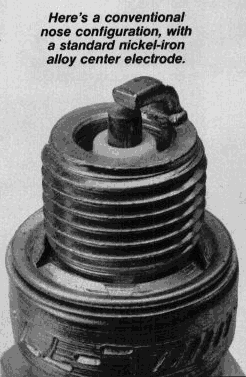 The first thing you have to learn is that there are some important differences in spark plugs' threaded ends, which are made in four diameters and lengths. Most plugs' thread diameter is a nominal 14 millimeters, but Honda -for example- uses 10mm plugs in small displacement engines and l2mm plugs spark all the Honda Fours. There also are 18mm plugs, seen only rarely in motorcycle applications despite the advantage they bring to two-stroke engines. At one time you had to cope with slight differences in thread configuration on spark plugs from different countries; this worry mercifully has been ended by an international standardization of thread forms.
The first thing you have to learn is that there are some important differences in spark plugs' threaded ends, which are made in four diameters and lengths. Most plugs' thread diameter is a nominal 14 millimeters, but Honda -for example- uses 10mm plugs in small displacement engines and l2mm plugs spark all the Honda Fours. There also are 18mm plugs, seen only rarely in motorcycle applications despite the advantage they bring to two-stroke engines. At one time you had to cope with slight differences in thread configuration on spark plugs from different countries; this worry mercifully has been ended by an international standardization of thread forms. 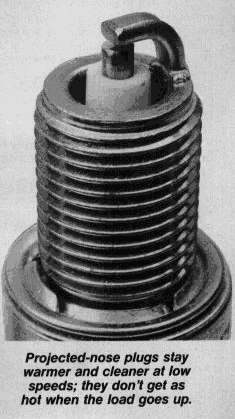 One very useful variation of the standard spark plug has its insulator nose and electrodes extended from its metal shell. The projected-nose configuration moves the spark gap a bit farther into the combustion chamber, which tends to improve efficiency by shortening the distance traveled by the flame front and also making the combustion process more regular. But there is a more important benefit: the projected-nose plug provides, in many engines, what effectively is a broader heat range than you get with the conventional flush-nose type. The projected nose is more directly exposed to the fire in the combustion chamber, and quickly comes up to a temperature high enough to burn away fouling deposits after ignition occurs. Then during the subsequent intake phase this plug's exposed tip is cooled by the swirling air/fuel mixture. In this fashion the higher temperatures existing at full-throttle operating conditions are to some extent compensated by the greater volume of cooling air, and the net effect is to make the projected-nose plug better able to cope with the conflicting demands of traffic and highway travel.
One very useful variation of the standard spark plug has its insulator nose and electrodes extended from its metal shell. The projected-nose configuration moves the spark gap a bit farther into the combustion chamber, which tends to improve efficiency by shortening the distance traveled by the flame front and also making the combustion process more regular. But there is a more important benefit: the projected-nose plug provides, in many engines, what effectively is a broader heat range than you get with the conventional flush-nose type. The projected nose is more directly exposed to the fire in the combustion chamber, and quickly comes up to a temperature high enough to burn away fouling deposits after ignition occurs. Then during the subsequent intake phase this plug's exposed tip is cooled by the swirling air/fuel mixture. In this fashion the higher temperatures existing at full-throttle operating conditions are to some extent compensated by the greater volume of cooling air, and the net effect is to make the projected-nose plug better able to cope with the conflicting demands of traffic and highway travel.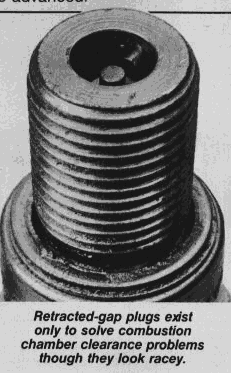 Limited plug/piston clearance in certain racing engines has prompted plug makers to create the recessed, or retracted gap, configuration. Champion inadvertently did everyone a great disservice by labeling its retracted-gap design as an "R" plug: people thought the letter meant "racing" and used the R-series in all kinds of high-performance applications, which was a terrible mistake. Even if an R-plug's heat range (all are very cold) is right, its gap placement lights the fire back in a hole and the combustion process never is quite as regular as it should be. The retracted-gap plug exists only because some engines present a clearance problem; it never was intended for use where conventional or projected-nose plugs can be fitted.
Limited plug/piston clearance in certain racing engines has prompted plug makers to create the recessed, or retracted gap, configuration. Champion inadvertently did everyone a great disservice by labeling its retracted-gap design as an "R" plug: people thought the letter meant "racing" and used the R-series in all kinds of high-performance applications, which was a terrible mistake. Even if an R-plug's heat range (all are very cold) is right, its gap placement lights the fire back in a hole and the combustion process never is quite as regular as it should be. The retracted-gap plug exists only because some engines present a clearance problem; it never was intended for use where conventional or projected-nose plugs can be fitted.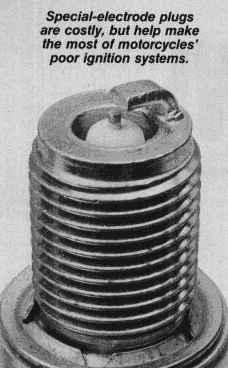 Platinum and gold-palladium alloys can survive the combustion chamber environment as very small wires, and in that rests their great advantage. Electrons leap away from the tip of a small-diameter, sharp-edged wire far more willingly than from one that's fatter and rounded. So the fine-wire plug requires less voltage to form a spark than one with conventional electrodes, and the difference becomes increasingly biased in the former's favor as hours in service accumulate and erosion blunts the iron-alloy electrodes. There are, of course, drawbacks with precious-metal plugs: they are more expensive, and they are very sensitive to excessive ignition advance. The overheating you get with too much spark lead effects plugs' center electrodes before it can be detected elsewhere in an engine, and when subjected to this kind of mistreatment fine-wire electrodes simply melt. In one sense this is a disadvantage, as it means the ruination of expensive spark plugs. Seen in another way it's a bonus feature: it is better to melt a plug electrode than an engine.
Platinum and gold-palladium alloys can survive the combustion chamber environment as very small wires, and in that rests their great advantage. Electrons leap away from the tip of a small-diameter, sharp-edged wire far more willingly than from one that's fatter and rounded. So the fine-wire plug requires less voltage to form a spark than one with conventional electrodes, and the difference becomes increasingly biased in the former's favor as hours in service accumulate and erosion blunts the iron-alloy electrodes. There are, of course, drawbacks with precious-metal plugs: they are more expensive, and they are very sensitive to excessive ignition advance. The overheating you get with too much spark lead effects plugs' center electrodes before it can be detected elsewhere in an engine, and when subjected to this kind of mistreatment fine-wire electrodes simply melt. In one sense this is a disadvantage, as it means the ruination of expensive spark plugs. Seen in another way it's a bonus feature: it is better to melt a plug electrode than an engine.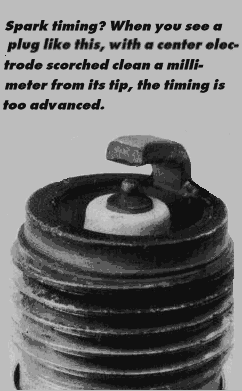 It's impossible to separate the question of ignition advance from the primary evidence of spark plug overheating, which is most strongly shown on the plug's center electrode. If you inspect this electrode's tip with a magnifying glass and see that its edges are being rounded by erosion, or melting, then you know there's overheating. You should also have a close look at the tip of the ground electrode, checking for the same symptoms. Finally, inspect the condition of the insulator, which should be white but with a surface texture about like it was when new; a porous, grainy appearance is evidence of overheating. If the signs of overheating are confined mostly to the center electrode you can bet you're using too much ignition advance. Retard the spark timing in small (two or three degrees) increments and as you get close to the optimum advance you'll find two things happening: first, the whole plug will be running colder; second, the center electrode will begin to acquire a film of fuel deposits extending out from the insulator nose toward its tip.
It's impossible to separate the question of ignition advance from the primary evidence of spark plug overheating, which is most strongly shown on the plug's center electrode. If you inspect this electrode's tip with a magnifying glass and see that its edges are being rounded by erosion, or melting, then you know there's overheating. You should also have a close look at the tip of the ground electrode, checking for the same symptoms. Finally, inspect the condition of the insulator, which should be white but with a surface texture about like it was when new; a porous, grainy appearance is evidence of overheating. If the signs of overheating are confined mostly to the center electrode you can bet you're using too much ignition advance. Retard the spark timing in small (two or three degrees) increments and as you get close to the optimum advance you'll find two things happening: first, the whole plug will be running colder; second, the center electrode will begin to acquire a film of fuel deposits extending out from the insulator nose toward its tip.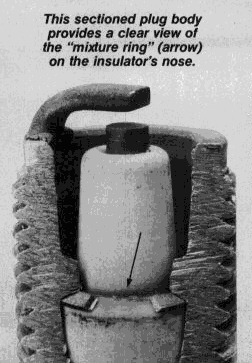 You won't find any soot out near the insulator nose, on a plug that's running hot enough to keep itself from fouling, because temperatures there are too high to let soot collect. But the insulator is much cooler deep inside the plug body, and coolest where it contacts the metal shell, which is precisely where you "read" mixture strength. Look far inside a plug, where its insulator joins its shell, and what you'll see there if your engine's mixture is too rich is a ring of soot. If this ring continues outward along the insulator to a width of even a millimeter you can be sure the mixture is rich enough to be safe, and too rich for maximum output. In most engines best performance is achieved when the mixture contains only enough excess fuel to make just a wisp of a "mixture ring" on the plug insulator. Air cooled two-stroke engines often will respond favorably to a slightly richer mixture, which provides a measure of internal cooling; some four-stroke engines give their best power when the mixture is leaned down to such extent that the last trace of soot deep inside the plug completely disappears.
You won't find any soot out near the insulator nose, on a plug that's running hot enough to keep itself from fouling, because temperatures there are too high to let soot collect. But the insulator is much cooler deep inside the plug body, and coolest where it contacts the metal shell, which is precisely where you "read" mixture strength. Look far inside a plug, where its insulator joins its shell, and what you'll see there if your engine's mixture is too rich is a ring of soot. If this ring continues outward along the insulator to a width of even a millimeter you can be sure the mixture is rich enough to be safe, and too rich for maximum output. In most engines best performance is achieved when the mixture contains only enough excess fuel to make just a wisp of a "mixture ring" on the plug insulator. Air cooled two-stroke engines often will respond favorably to a slightly richer mixture, which provides a measure of internal cooling; some four-stroke engines give their best power when the mixture is leaned down to such extent that the last trace of soot deep inside the plug completely disappears.